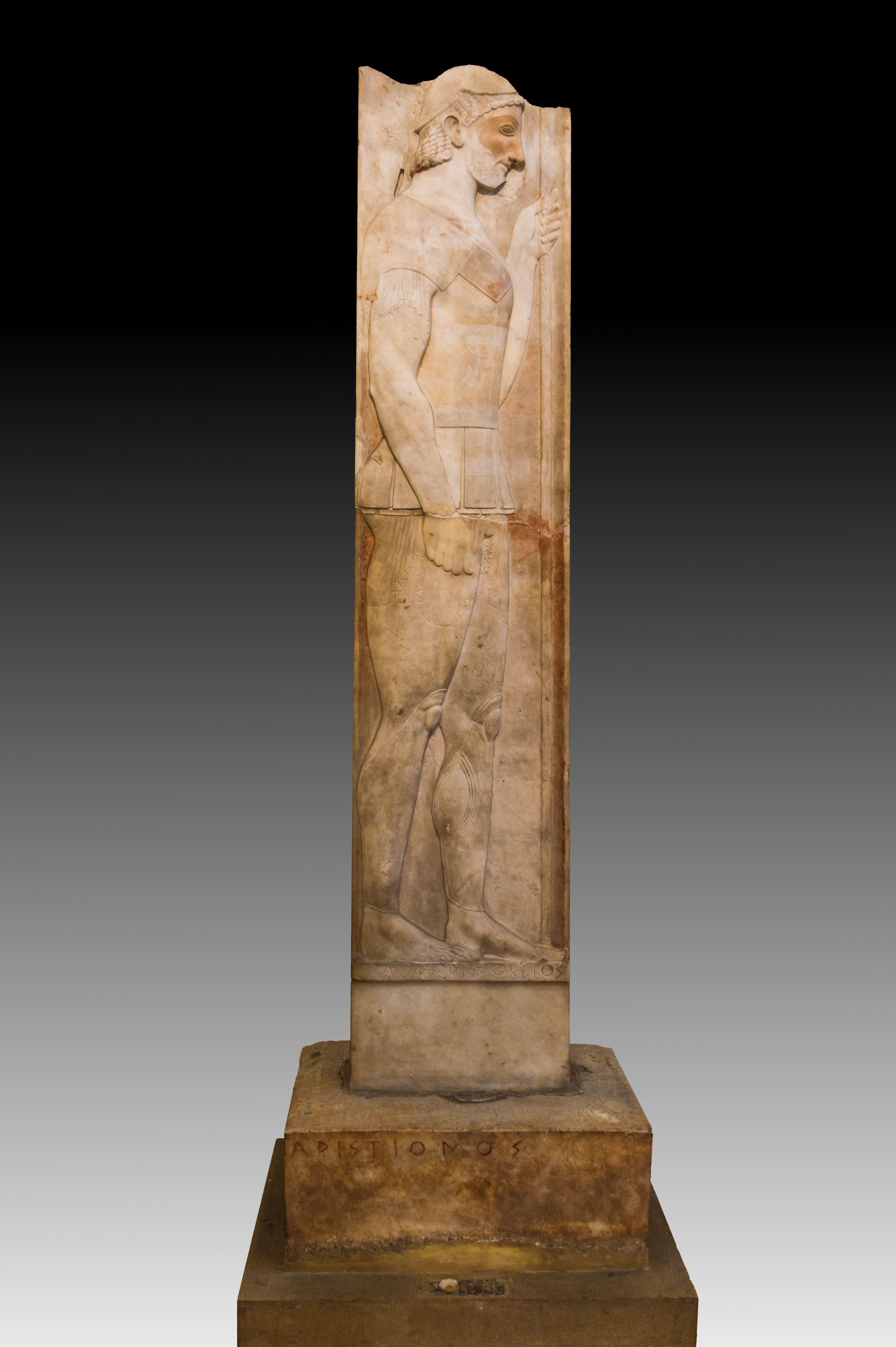Stele Of Aristion on:
[Wikipedia]
[Google]
[Amazon]
 The Stele of Aristion dates from around 510 BC. It was created by sculptor Aristokles out of Pentelic marble and shows traces of polychrome. It was found at Velanideza near
The Stele of Aristion dates from around 510 BC. It was created by sculptor Aristokles out of Pentelic marble and shows traces of polychrome. It was found at Velanideza near
Cape, Greece. Although the Stele is currently white, this would not have been the case of the Classical antiquity, Archaic period of Attica. It was not an uncommon practice to add polychrome as a decorative element of marble stele. The Stele of Aristion was originally decorated with painted designs: meanders, zig-zags, along with a star on his shoulder. There are also remnants of red pigment located on the ground of the relief, on the end of the shoulder strap, and on the drapery. The amour of the soldier would have been a blue tint, and the hair would be that of a dark colour.
 The Stele of Aristion dates from around 510 BC. It was created by sculptor Aristokles out of Pentelic marble and shows traces of polychrome. It was found at Velanideza near
The Stele of Aristion dates from around 510 BC. It was created by sculptor Aristokles out of Pentelic marble and shows traces of polychrome. It was found at Velanideza near Marathon
The marathon is a long-distance foot race with a distance of , usually run as a road race, but the distance can be covered on trail routes. The marathon can be completed by running or with a run/walk strategy. There are also wheelchair div ...
in Attica.
Description
The Stele of Aristion or the Marathon Stele is a funerarystele
A stele ( ),Anglicized plural steles ( ); Greek plural stelai ( ), from Greek , ''stēlē''. The Greek plural is written , ''stēlai'', but this is only rarely encountered in English. or occasionally stela (plural ''stelas'' or ''stelæ''), whe ...
in the National Archaeological Museum, Athens (NAMA, inventory number 29) which dates from around 510 BC. The work is among the best sculptures from late Archaic Greece
Archaic Greece was the period in Greek history lasting from circa 800 BC to the second Persian invasion of Greece in 480 BC, following the Greek Dark Ages and succeeded by the Classical period. In the archaic period, Greeks settled across the ...
. It is made of Pentelic marble and measures 2.02 m high. The stele was found with its base, which is 0.24 m high. The uppermost portion of the head and helmet is missing. At the top of the base is an inscription, giving the name of the deceased in the genitive
In grammar, the genitive case (abbreviated ) is the grammatical case that marks a word, usually a noun, as modifying another word, also usually a noun—thus indicating an attributive relationship of one noun to the other noun. A genitive can al ...
: "Aristion's".
Aristion is depicted as a bearded hoplite
Hoplites ( ) ( grc, ὁπλίτης : hoplítēs) were citizen-soldiers of Ancient Greece, Ancient Greek Polis, city-states who were primarily armed with spears and shields. Hoplite soldiers used the phalanx formation to be effective in war with ...
soldier in profile, facing right. He wears a short, thin chiton
Chitons () are marine molluscs of varying size in the class Polyplacophora (), formerly known as Amphineura. About 940 extant and 430 fossil species are recognized.
They are also sometimes known as gumboots or sea cradles or coat-of-mail s ...
under a corselet. This was originally decorated with painted designs: meanders, zig-zags, and a star on his shoulder. The rest of the statue was also extensively decorated with paint—traces of red, yellow, and blue paint still survive. Aristion also wears an Attic helmet and greaves. His right arm hangs at his side, his left hand holds a spear. Some details are especially well-worked, like the wavy beard, the hair, and the musculature of the arms, legs and chest. In the empty space under his feet there is a horizontal inscribed band, which names the sculptor of the stele: "Work of Aristokles".
Creation
The sculptor Aristokles was known to have his signature on several bases, but his only famous work is Stele of Aristion. His name then appears on an Attica inscription found at HierakCape, Greece. Although the Stele is currently white, this would not have been the case of the Classical antiquity, Archaic period of Attica. It was not an uncommon practice to add polychrome as a decorative element of marble stele. The Stele of Aristion was originally decorated with painted designs: meanders, zig-zags, along with a star on his shoulder. There are also remnants of red pigment located on the ground of the relief, on the end of the shoulder strap, and on the drapery. The amour of the soldier would have been a blue tint, and the hair would be that of a dark colour.
See also
* '' Grave Stele of Pollis'' - Archaic to Classical ( Severe style) stele of a similar profile, now housed at the Getty VillaFootnotes
Bibliography
* Nikolaos Kaltsas: ''Sculpture in the National Archaeological Museum, Athens''. The J. Paul Getty Museum, Los Angeles 2002, , p. 70. {{National Archaeological Museum of Athens Archaeological discoveries in Attica National Archaeological Museum, Athens 1st-millennium BC steles Ancient Greek tombs 6th-century BC Greek sculptures Marble reliefs Sculptures in Athens Sculptures of men in Greece Marble sculptures in Greece 1876 archaeological discoveries Reliefs in Greece